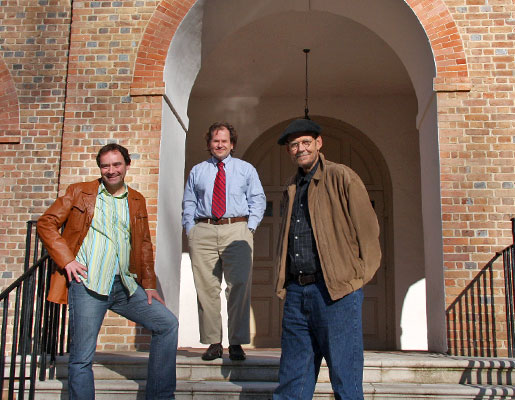A sublime history
Essays explore the noumenal experience over the ages
If you were to stand at the edge of the Grand Canyon, or observe the Mona Lisa in real life at the Louvre, you might be lucky enough to experience what Timothy Costelloe calls the Sublime—but only if the experience is literally awesome.
“The term itself really describes a certain kind of experience in which we’re somehow taken outside of a worldly practical condition,” explains Costelloe. “We experience something of a nature which is noumenal rather than phenomenal.”
Noumenal, Costelloe says, is a philosopher’s term. It describes something that is outside the realm of human cognition, something that simply is taken to exist but is not sensed, such as a belief in God. The phenomenal, by contrast, he explains, is given to us as part of everyday experience.
However, the sublime is known to us simply by nature of being sublime.
Exploring the transcendent aesthetic experience
Costelloe, an associate professor of philosophy at William & Mary, has edited a volume of original essays written by a variety of scholars from different disciplines, each of which considers the nature of the sublime, that transcendent aesthetic experience that philosophers and other writers have discussed at least since the third century AD.
Among those who wrote essays for The Sublime: From Antiquity to the Present are two other William & Mary professors. Adam Potkay is a professor of English who contributed an essay on the sublime in the British Romantic tradition, and Chandos Brown is an associate professor of history and American studies, whose chapter describes the sublime as it relates to the establishment and growth of the American republic.
Costelloe had the idea for this volume during a seminar sponsored by the National Endowment for the Humanities. The seminar on German and British aesthetics brought him together with professors of various backgrounds and interests, and the idea for his volume was born.
Costelloe says the sublime can be found across an array of contexts, and he was surprised to discover that there was no single volume that addressed the sublime and critical consideration of it.
“The idea out there is that the sublime is somehow dead,” says Costelloe. “But it’s a concept that tries to characterize an experience that we do have. So the idea that it’s somehow dead is a bit strange.”
Starting with the history of the concept
Costelloe divides his volume into two different parts. The first part focuses on a set of historical theories that attempt to define and explain the sublime, and how those theories changed over time. The second part contains various applications of these views as well as specific ways in which the sublime has been worked out in other disciplines and practical endeavors—art, architecture and our appreciation of the natural environment.
Potkay’s essay “The British Romantic Sublime” revolves around his specialty in the literature and poetry of the British Romantic period. According to Potkay, the sublime as it pertains to the Romantics acts as a vehicle for attaining a higher morality.
“One transcends one’s immediate environment and self-interested relations in order to emerge a fully moral being” says Potkay in his essay. It is the recognition of great virtue, pervading love, or the category of morality itself, he explains.
Brown brings the sublime into an American context with his essay “The First American Sublime.” Brown says in his piece that he considers the American sublime as it relates to imperial expansion, revolution, the pursuit of knowledge and the difference between natural and national history.
Beginning with Longinus—or perhaps, pseudo-Longinus
The first known author to treat the sublime is himself shrouded in mystery. Longinus, or “pseudo-Longinus” as he is often referred to, in light of debates over his existence and identity, is the first to articulate the sublime, which he does in terms of literary and poetic language in the third century AD, explains Costelloe.
From the nature and origins of Longinus’ On the Sublime—the subject of the first chapter of the book—The Sublime then moves to what Costelloe terms the heyday of philosophical attention to the subject, a period that stretches from the early eighteenth to the latter part of the nineteenth century.
“Many Scottish and English philosophers in the 18th and 19th centuries have something to say about the subject; they’re all trying to give an account of what this experience amounts to and to distinguish it from beauty,” says Costelloe.
There is a difference in the nature of experiences that constitute the sublime and the beautiful, says Costelloe. When you experience beauty there is something soft and calming that settles over you. Costelloe, and the authorities who wrote the essays in his book, agree that something quite different happens when you’re in the presence of the sublime. A truly sublime experience is almost violent, he says, an eruption within the person that takes him or her out of the present, and for a moment appears to transcend space and time.
The sublime takes us out of everyday life
There are many ways in which the sublime might touch our lives and remove us, albeit temporarily, from the constraints of everyday life. Elements such as the environment and religion, as well as the sublime as it pertains to certain literatures, fine arts and architectures are all discussed in the second portion of Costelloe’s volume in the light of a kind of practical application.
Costelloe believes experiencing the sublime is a pivotal part of the ordinary human experience.
“The sublime
occurs only in moments that we experience this,” he says, “where you feel that
you’ve somehow experienced time out of mind.” It is, he added, the briefest
instant of being so awestruck, that you feel unbound by the temporal world. ![]()
















